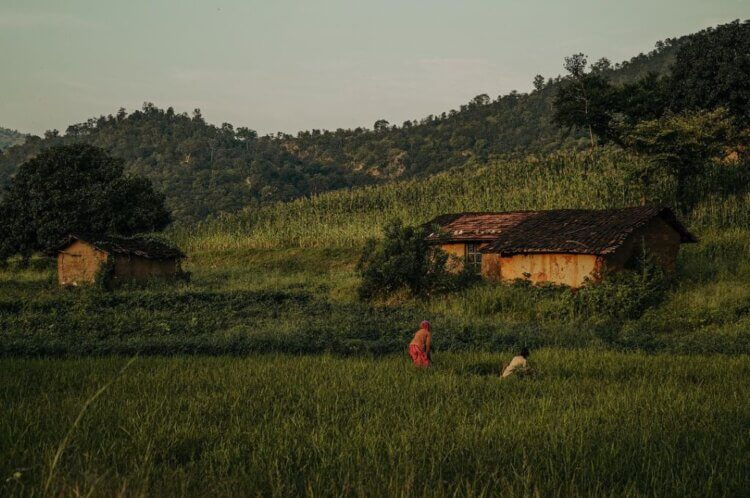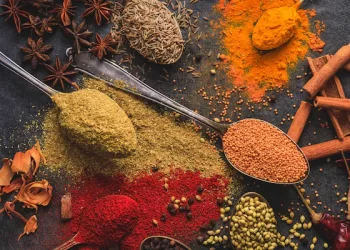Neema Devi sits with her sister-in-law, Prema Devi, threshing wheat by hand in the village of Dhudholi, in the Indian state of Uttarakhand. Harvesting season is over and, in exchange for threshing wheat in their neighbour’s courtyard, the two women receive hay for their cattle. Neema (Devi is generally an honorific for married women, rather than a family name) says their land is too small to provide them with enough hay. With their tiny plots, people like Neema Devi and Prema Devi are in the forefront of those dealing with climate impacts.
The Himalayas are warming faster than the global average, which has immediate repercussions on agriculture, altering crop cycles, growing seasons and soil moisture. In Uttarakhand, a primarily mountainous province, with some foothills and plains, the problem is magnified because the majority of farmed land–according to the most recent census done in 2011–consists of ‘marginal’ plots of less than 1 hectare, (36% of the state’s total farmed land) or small ones (1-2 hectares, 28% of the area).
Small landholdings make it harder to adapt
Not everybody is equally hard hit. As one study points out, while all socio-economic groups are represented among small and marginal farmers, this is not true of large farm landholdings (over 4 hectares). Almost none of these are owned by Scheduled Caste, or Dalit, community members. Historically repressed, the Dalit community–to which Neema Devi and Prema Devi belong–has made progress since India’s independence, but their marginalisation is still evident in small landholdings. Climate change threatens even this limited progress.
As climatic conditions change, some farmers in Uttarakhand are turning to new crops.
“Forget about selling [crops]; if we can grow enough to feed ourselves, we’re thankful,” says Neema Devi.
As climatic conditions change, some farmers in Uttarakhand are turning to new crops, with help from the government or NGOs, to maintain profitability. Unfortunately, this is not possible for many women and Dalit farmers.
Although the state government now subsidises the distribution of kiwi plants, raising the fruit requires a significant investment.
“If you want an orchard, you will need support in the form of angle iron, which is a T-shaped support system for [each] plant, and in one nali [approximately 0.049 of an acre] of zameen [land] one can grow only eight trees, and one angle iron costs INR 4,000-5,000 [USD 50-60],” says Pawan, who works with the Institute of Himalayan Environmental Research and Education (INHERE), an NGO focused on sustainable development in the Himalayas. The cost of this infrastructure alone, before transportation and other inputs, would be nearly INR 40,000 (USD 500), roughly what an average resident of Uttarakhand earns in two months.
Such investment is beyond the means of small and marginal farmers who earn much less than the average income, especially as kiwi plants take 3-5 years to start bearing fruit.
Another climate adaptation initiative the government and other organisations are suggesting is the cultivation of herbs and medicinal crops. But this needs a lot of land, which poorer farmers, women farmers, or Dalit farmers, are not likely to have.
“If we just sell the leaves of tulsi, the market price is really low, and if we sell the oil extracted from it, the rates are higher, but [a plant] only provides a very small quantity [of oil],” says Pawan from INHERE. The same is true for lemongrass, he adds: “If you need 100 millilitres of lemongrass oil, you’ll need at least 10 quintals [one metric ton] of produce, which covers a large area.”
Organic farming is another tack pursued by the government and various NGOs to help people adapt to climate change. The Uttarakhand State Organic Certification Agency (USOCA) was set up to facilitate the shift. The emphasis is on indigenous crops like finger millet and barnyard millet, which are more climate resilient, mould-resistant, and can often grow without irrigation. However, USOCA’s non-discriminatory policy pledges ring hollow when lack of resources create barriers to small or marginal farmers adopting organic farming.
“Many Dalit families don’t even have enough livestock to make cow dung fertiliser,” says Geeta Bisht, an agriculture specialist from INHERE.







 Finance
Finance







